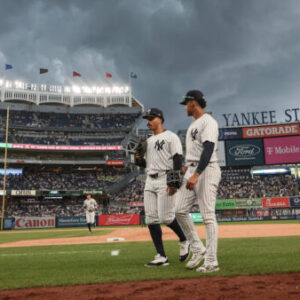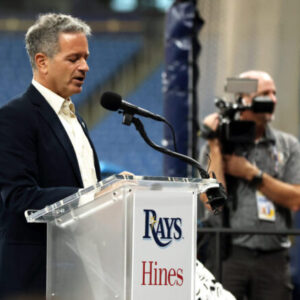My 2024 National League Rookie of the Year Ballotby Dan Szymborski November 18, 2024Denis Poroy-Imagn ImagesBaseball’s awards season is in full swing this week. Tonight, the National League Rookie of the Year award, officially known as the Jackie Robinson award since 1987, was awarded to Paul Skenes, who was impressive enough to also be a finalist in the NL Cy Young award voting. Skenes finished with 23 first-place votes to Jackson Merrill’s seven.

I’m not here to praise or criticize the results. Instead, I’m here to perform what I see as my journalistic duty. I was an NL Rookie of the Year voter this year (my sixth time voting for the award), and I have always felt that it’s important to give a detailed explanation of the reasoning behind my choice.
As usual, I spent most of the final weekend of the season agonizing over my choices, because while being asked to vote for one of these awards is admittedly really cool, it’s also a weighty responsibility that demands care as well as candor. Offering a breakdown of my vote hasn’t always been fun — in 2021, my decision to vote for Trevor Rogers over Jonathan India resulted in my social media mentions being inundated with a combination of threats and insults — but I think I owe it to the fans and the players involved to explain myself. (OK, some of the brouhaha in 2021 was fun, like the suggestion that the Cincinnati Reds should fire me, a notion that still amuses me on many levels.
)For my first-place vote this year, I took Merrill over Skenes. This was not an easy choice, and I’ve spent much of the time since I cast my vote second-, third-, fourth-guessing whether I made the right decision. Unlike India vs.
Rogers, or Spencer Strider vs. Michael Harris II, I will probably go to the grave not being entirely certain that I drank from the right grail. As usual, I started with the numbers.
How could I not? In baseball, a sport that largely consists of individual duels set within a team context, the numbers do a very good job of describing what happened, how it happened, and who should get the credit or blame for it. The WAR framework that we use is highly useful for giving us the basic lay of the land, but the differences between it and other versions of the stat don’t necessarily make a conclusion here obvious.
Our version of WAR, referred to as fWAR when Baseball-Reference’s WAR (bWAR) is also being discussed, gives Merrill a 5. 3 to 4. 3 edge.
Meanwhile, bWAR, which has its own interpretation of the generalized framework that makes up all WAR measures, using different defensive numbers and a different pitcher run assignment philosophy, has Skenes with the edge, 5. 9 to 4. 4.
The downsides of each WAR measure for pitchers are clear. The danger with fWAR is that it can underdescribe. While we have very good reasons for believing that the vast majority of a pitcher’s contributions come in their performance in the so-called three true outcomes (home runs, walks, and strikeouts), we intentionally leave out the lesser, small stuff, even though that we know it matters a little.
Meanwhile, bWAR risks overdescribing, starting with runs allowed and very broadly adjusting for overall team defense. This creates a situation where we aren’t leaving out information, but rather are including quite a bit that we’re not actually sure is true. By way of example, imagine this was an article about the 2002 NL Cy Young award, and I was evaluating Tom Glavine.
By 2002, Glavine had about 15 years of performance behind him, allowing us to make a more educated assessment of his ability to prevent runs from scoring, above and beyond his peripheral numbers. In his case, I see a bWAR approach as having more merit, since he did display a modest but real ability to keep runs from scoring, better than you’d expect from his FIP numbers and the estimates of Atlanta’s defense. The WAR that ZiPS uses (zWAR) attempts to deal with this — it would lean more on a bWAR approach than an fWAR approach the longer a pitcher’s career stretches.
But it’s still unclear if a pitcher like Skenes, who has 133 innings in the majors and 34 in the minors, is going to consistently beat his FIP. It’s not enough to know he’s great; Roger Clemens had an almost identical ERA and FIP, while Greg Maddux gets there once you adjust for defense (the Braves were the top Total Zone team from 1993 to 2003 by more than 150 runs over the second-place Cardinals). And other differences between fWAR and bWAR point to why neither version is enough on its own to settle this debate.
Merrill has the edge over Skenes in fWAR, but that edge owes something to his very good StatCast defensive numbers, which fuel the defensive component of our WAR. Meanwhile, Defensive Runs Saved, which is calculated by Sports Info Solutions and used in bWAR, sees his defense as average rather than superlative. Given the volatility of defensive metrics over a single season, it’s important not ascribe too much precision to WAR as a stat.
It’s useful, to be sure, and Merrill certainly looks like a good defender, but it has error bars like any stat does. In the end, I had to make the choice based more on non-statistical grounds. I like to look at the context around the performances in these situations.
Who had the tougher road to travel? Who showed the most growth? It’s these questions that gave Merrill the tiniest edge for me.
Skenes didn’t have the benefit of a whole lot of time in the upper minors, but he also debuted in a relatively low-pressure environment. Yes, as the former first overall pick there was a lot of hype for him to live up to, but the Pirates were able to bring him along conservatively. He wasn’t asked to throw 180 innings in 2024.
Pittsburgh was a below-. 500 team that wasn’t expected to be a serious contender, so him not being an instant star wasn’t a do-or-die scenario. Of course, he was an instant star, and one who I expect to regularly enter the season as a Cy Young favorite, but the Pirates weren’t reliant on him being that guy from the second he debuted, as his rookie campaign wasn’t the difference between them making the postseason or sitting home in October.
To me, Merrill’s path seemed like the rockier one. The Padres subtracted one of the league’s biggest bats when they traded Juan Soto during the offseason, and no one was brought in with an eye toward convincingly mitigating that loss. The projected starting left fielder, Jurickson Profar, was coming off a .
242/. 321/. 368, -1.
6 WAR season. Center field had little after Merrill; José Azocar and Jakob Marsee would have easily projected as the game’s worst starters at the position if they had been used in that way. Merrill was trusted with the position from the very first day of the season despite never having played in Triple-A; his sole high minors experience was a third of a season at Double-A San Antonio.
Already hindered by minimal experience in the high minors, he had to adjust to major league pitching while debuting as a center fielder, a position he had never played professionally before spring training. Indeed, Merrill’s only professional outfield experience before the spring was five games in left field last year. Merrill did all of that on a team that was expected to be a serious playoff contender, and he did it well.
His line wasn’t impressive in the early going, but as the playoff race heated up, so did he; from June on, he slugged . 571 and ranked 11th in baseball with 4. 4 WAR.
And while we can’t yet be certain whether his defense in center field is in Gold Glove territory (OAA) or merely average (DRS), it’s undeniable that he did a lot more than simply cosplay there based on team need, offering real defensive value at the position. The slightly higher degree of difficulty that Merrill faced was enough for me to put him in first place. …Oh, right, there’s more!
Far more went into determining my first and second place votes than usual, so I’ll try to be brief when discussing the rest of the rookies I considered. Jackson Chourio got my third-place vote. He had a really solid season, hitting .
275/. 327/. 464 for a 117 wRC+ and 3.
9 WAR. But being just behind Merrill at a similar position in a similar situation meant that he was a third-place candidate for me. The question was whether to choose him or Masyn Winn, who was a highlight for the Cardinals in their sorta bounce-back 2024 season.
I’m more confident in Chourio’s defensive numbers than Winn’s because of the consistency between the different metrics, so I gave the former the very slight edge; Winn would have been my theoretical fourth-place vote. I was especially impressed by Chourio’s improvement in terms of plate discipline and contact quality as the season went on — as he became more selective, he also hit the ball harder:It wasn’t a slam dunk for either, however. Extend the season by a month and I think that my third-place vote may very well have ended up going to Tyler Fitzgerald, who led all the serious rookie candidates in both leagues with a 132 wRC+ but only played in 96 games in the majors.
I have a history of voting for players who post a crazy 100 or so games when the other options aren’t compelling, but both Chourio and Winn played near an All-Star level in a full season, making it just too much of a stretch for me. But at 115 or 120 games? I think I might have voted in Fitzgerald’s favor.
Shota Imanaga and Yoshinobu Yamamoto both had very good seasons — Yamamoto missed a lot of time due to a sore shoulder — but were clearly a tier below the top candidates. Joey Ortiz was an early favorite, going bananas in his debut with the Brewers, but he was downright awful in the second half, enough to drop him out of contention. Michael Busch hit well but didn’t provide a ton of positional value, and as fabulous as Pete Crow-Armstrong’s defense was, his bat wasn’t up to the same standards.
There was a clear drop-off after that group, though I would have enjoyed having to split hairs on a 10-player ballot had one been put to me. That wraps up my NL Rookie of the Year contribution this year, but don’t worry. I get my Hall of Fame ballot next year, so there will be even more opportunities to be annoyed with me next time around!
The Big Questions About the 2025 BBWAA Hall of Fame Ballot Dan Szymborski is a senior writer for FanGraphs and the developer of the ZiPS projection system. He was a writer for ESPN. com from 2010-2018, a regular guest on a number of radio shows and podcasts, and a voting BBWAA member.
He also maintains a terrible Twitter account at @DSzymborski. This post was originally published on this site be sure to check out more of their content.





